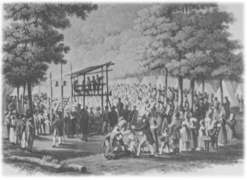The Last Will and Testament of Springfield Presbytery (1808)
| Richard McNemar | The Last Will and Testament of Springfield Presbytery (1808) |
FROM
| HERALD OF GOSPEL LIBERTY. | ||
| BY ELIAS SMITH. | ||
| NO. 1. ] | THURSDAY EVENING, SEPTEMBER 1, 1808. | [ VOL. 1. |
| "FROM REALMS FAR DISTANT, AND FROM CLIMES UNKNOWN: WE MAKE THE KNOWLEDGE OF OUR KING YOU OWN." | ||
Revival of Religion--and Reformation in Kentucky.
Within seven years past, there has been the greatest out-pouring of the spirit of God, in Kentucky, Tennessee, and the adjacent parts, even known since the settlement of North-America. It has been extended not only t the conversion of Atheists, Deists, and men of wretched characters, of every rank, from the highest to the lowest: but it has produced a reformation in those who had formerly professed religion under the fashionable party names now contended for in the world.
It is our design in future numbers, to give the readers an account of the beginning and progress of the revival, and, the view those reformed ministers and churches have of the church of Christ, as described in the new testament.
Those men have agreed to give up all the party names and rules made by men, and to name the name of Christ, and walk by his rule, which is the New Testament. The Presbyterians of Springfield have dissolved the Presbyterian body, and have given an account of it to the public in the following singular curious will; called, "The last will and testament of
SPRINGFIELD PRESBYTERY.
The Presbytery of Springfield, sitting at Caneridge, in the county of Bourbon, being through a gracious Providence, in more than ordinary bodily health, growing in strength and size daily, and in perfect soundness and composure of mind; but knowing that it is appointed for all delegated bodies once to die and considering that the life of every such body is very uncertain, do make and ordain this our Last Will and Testament, in manner and form following, viz:
Imprimis. We will that this body die, be dissolved, and sink into union with the Body of Christ at large: for there is but one body and one spirit, even as we are called in one hope of our calling.
Item. We will, that our name of distinction, with its Reverend title, be forgotten, that there be but one Lord over God's heritage, and his name one.
Item. We will, that our power of making laws for the government of the church, and executing them by delegated authority, forever cease; that, the people may have free course to the Bible, and adopt the law of the spirit of life in Christ Jesus.
Item. We will, that candidates for the Gospel ministry henceforth study the holy scriptures with fervent prayer, and obtain license from God to preach the simple Gospel with the Holy Ghost sent down from heaven, without any mixture of philosophy, vain deceit, [2] traditions of men, the rudiments of the world. And let none henceforth take this honor to himself, but he that is called of God, as was Aaron.
Item. We will, that the church of Christ assume her native right of internal government--try her candidates for the ministry, as to their soundness in the faith, acquaintance with experimental religion, gravity and aptness to teach; and admit no other proof of their authority, but Christ speaking in them. We will that the church of Christ look up to the Lord of the harvest to send forth labourers into his harvest; and that she resume her primitive right of trying those who say they are Apostles, and are not.
Item. We will, that each particular church, as a body, actuated by the same spirit, choose her own preacher, and support him by a free will offering without written call or subscription--admit members--remove offences; and never henceforth delegate her right of government to any man or set of men whatever.
Item. We will, that the people henceforth take the Bible as the only sure guide to heaven; and as many as are offended with other books, which stand in competition with it, may cast them into the fire if they choose: for it is better to enter into life having one book, than having many to be cast into hell.
Item. We will, that preachers and people, cultivate a spirit of mutual forbearance, pray more and dispute less; and while they behold the signs of the times, look up and confidently expect that redemption draweth nigh.
Item. We will, that our weak brethren, who may have been wishing to make the Presbytery of Springfield their king, and wot not what is now become of it, betake themselves to the rock of ages, and follow Jesus for the future.
Item. We will, that the Synod of Kentucky examine every member, who may be suspected of having departed from the Confession of faith, and suspend every such suspected heretic immediately; in order that the oppressed may go free, and taste the sweets of Gospel liberty.
Item. We will, that Ja---------, the author of two letters lately published in Lexington, be encouraged in his zeal to destroy partyism. We will, moreover, that our past conduct be examined into by all who may have correct information; but let foreigners beware of speaking evil of things which they know not.
Item. Finally we will, that all our sister bodies, read their Bibles carefully, that they may see their fate there determined, and prepare for death before it is too late.
| Springfield Presbytery, June 28th, 1804. | } | (L. S.) |
| ROBERT MARSHALL, JOHN DUNLAVY, RICHARD M'NEMAR, B. W. STONE, JOHN THOMPSON, DAVID PURVIANCE. | Witnesses. |
[Herald of Gospel Liberty 1 (September 1, 1808): 2-3.]
| Richard McNemar | The Last Will and Testament of Springfield Presbytery (1808) |



